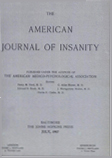THE QUESTION OF AUTOINTOXICATION IN ACUTE DEPRESSIVE PSYCHOSES
Abstract
The chemical analyses of the feces revealed nothing which could be called distinctly pathological, though skatole was once found in small quantity (2.6 mgms. per 100 gms. feces) and in many instances the phenol was very high, much higher than that observed by Herter in his cases of advanced anæmia. Herter found the average elimination to be about 9 mgms. while here it was slightly over 20 mgms. Indole was found in traces only.
In Case VI strong indications of intestinal putrefaction were obtained from the analyses of the culture media. On one occasion 218 mgms. of indole and 93 mgms. of phenol were obtained from 100 ccm. of culture media. On a later examination in the absence of indole, 3 mgms. of skatole were obtained. In Case IX a marked production of indole was observed in both the plain bouillon and in the plain bouillon and calcium carbonate.
In the urine examinations of Cases V, VI and IX, the ethereal sulphates were all high with low sulphate ratios. In these same cases the phenol values were all considerably above the normal, while on some occasions the indican was possibly a little high.
Three of the nine cases examined, viz., V, VI, and IX, especially V and VI, gave considerable indication of intestinal putrefaction. The diet of both Cases V and VI was almost exclusively of milk and that makes these observations all the more remarkable. These two cases have both been discharged as recovered, while the condition of Case IX remains stationary, symptoms of mental depression still being exhibited.
It would seem that in the psychoses studied, the question of autointoxication or more properly autoinfection was one which should always be considered, at least as an influencing factor; although at the present time the analytical data are insufficient to ascribe definitely certain nervous or other disorders to an autointoxication.
Access content
To read the fulltext, please use one of the options below to sign in or purchase access.- Personal login
- Institutional Login
- Sign in via OpenAthens
- Register for access
-
Please login/register if you wish to pair your device and check access availability.
Not a subscriber?
PsychiatryOnline subscription options offer access to the DSM-5 library, books, journals, CME, and patient resources. This all-in-one virtual library provides psychiatrists and mental health professionals with key resources for diagnosis, treatment, research, and professional development.
Need more help? PsychiatryOnline Customer Service may be reached by emailing [email protected] or by calling 800-368-5777 (in the U.S.) or 703-907-7322 (outside the U.S.).



